 Japanese seaplane tenders/Oilers 1919-1922: Notoro*, Shiretoko, Erimo, Sata, Tsurumi*, Shiriya, Irō 1922-45.
Japanese seaplane tenders/Oilers 1919-1922: Notoro*, Shiretoko, Erimo, Sata, Tsurumi*, Shiriya, Irō 1922-45.
IJN Notoro and Tusurumi were rare case of seaplane carriers, born oilers, and returned back to oilers, the first in 1942, the second in 1931. But during their service for the IJN as seaplane carriers they brought a lot of experience in this area of converted, dual purpose ships. The idea was not only to circumvent the Washington treaty’s tonnage limitation on aircraft carrying, being auxiliaries, but also to keep an edge after the success of Wakamiya in 1914, notably during the siege of Tsingtau. Many other dedicated seaplane tenders were indeed planned for the upcoming years, including some that could be rapidly converted as carriers in wartime. Notoro took part in the war in China and the 1932 Shanghai incident, and 1937 war. She also worked with the combined fleet and operated successively Yokosuka EY1s, Kawanishi E7K and Nakajima E8Ns. In WW2 she was damaged thrice, the second by two torpedoes from USS Flasher on 29 June 1944 but she survived before being bombed by B-29s in November in Singapore and never repaired. Tsurumi was converted in 1924 and was reconverted as oiler in 1931, working as such until sunk by USS Cero (SS-225) in August 1944.
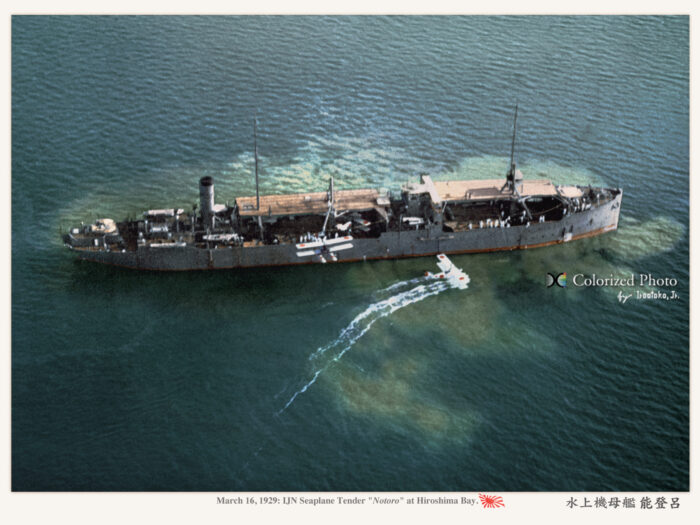
IJN Notoro in 1929. Colorized by Irootoko Jr src
Development
IJN Notoro was part of the 7-strong Notoro-class oilers (能登呂型給油艦, Notoro-gata kyūyukan) built for the Imperial Japanese Navy (IJN), also taking the name Erimo-class oilers after Notoro and Shiretoko were converted. They had been planned under the pre-Eight-eight fleet plans: The Eight-four fleet plan and the Eight-six fleet plan. All these ships were named after famous capes around the home islands. Their role was to carry vital oil for the IJN, importing crude oil from North America and Southeast Asia. So the class was directly concerned by the embargo of 1940 but we are way ahead there. These ships made 388 voyages carrying for a total of 3,000,000 tons up to 1941, including Notoro. They were built at Kawasaki-Kōbe Shipyard, Yokohama Dock Company and Ōsaka Iron Works, and Sakurajima Factory.
The class comprised the following:
IJN Notoro (Kawasaki-Kōbe) laid down 24 November 1919, launched 17 July 1920, comp. 20 September 1920. BU in Singapore 12 January 1947.
IJN Shiretoko (Kawasaki-Kōbe) LD 24 November 1919, LC 3 May 1920, CP 10 August 1920, collier 1928, Munition ship 1941, sunk air raid Singapore 1 February 1945.
IJN Erimo (Kawasaki) LD 3 May 1920, LC 28 October 1920, CP 16 December 1920, torpedoed Dutch sub O 15 4 March 1942, grounded Belitung, TCL*.
IJN Sata (Yokohama) LD 6 March 1920, LC 28 October 1920, CP 24 February 1921, Conv. sub rescue ship 1938. Sunk Palau 31 March 1944.
IJN Tsurumi (Ōsaka) LD 10 March 1921, LC 29 September 1921, CP 14 March 1922, sunk by USS Cero, Davao 5 August 1944.
IJN Shiriya (Yokohama) LD 7 April 1921, LC 29 September 1921, CP 8 February 1922, sunk by USS Trigger, Keelung 22 September 1943.
IJN Irō (Ōsaka) LD 2 September 1921, LC 5 August 1922, CP 30 October 1922, heavily damaged, air raid Palau 31 March 1944, Sank 17 April.
During World War II those not converted were not part of the combined fleet, due to their low speedbut operated instead to supply runs of various naval bases in the Pacific, in particular Palau and Truk.
Design of the class
These were typical of 1918 oilers in design and construction, “three island” type with a forecastle and straight stem, adorned with a platform and main gun, amidship bridge island, and sterncastle, clipper style poop with another main gun on platform. The latter part housed the machinery space and topped by a tall funnel. The intermediate spaces about 1/2 of the total lenght, were devoted to oil tanks, four total, with the “pipe forest” above, and four boom cranes, two aft, two forward to hoist the flexible hose used for at sea resplenishment, albeit this was done in a stationary position, not underway at the time. Total Capacity was 8,000 tons of fuel oil, enough to completely resupply a Yamato class (6300t) and a heavy cruiser, or two full squadrons of destroyers.
Hull and general design
The Notoro class displaced 15,400 long tons (15,647 t) standing for a lenght of 138.68 m (455 ft) between perpendicular and a beam of 17.68 m (58 ft) making for a 1/8 ratio. Draught was important of course, at 8.08 m (26 ft 6 in) mean (loaded).
Powerplant
All apart Irō were given a triple expansion reciprocating engine fed by Scotch boilers, a power passed onto a single shaft for 3,750 shp (2,800 kW).
Irō instead had four military grade Kampon water tube boilers but the same output. Top speed was 12 knots (22 km/h; 14 mph).
They lacked any armour Protection but their nature made them quite resilient to torpedo attacks. Like most oilers the fuel oil they carried buffered from torpedo explosions, and they usually could survived up to two hits. They had a partial double hull, and strong bulkheads due to the enormous weight of crude oil maintained under pressure, which added to this protection. Six main bulkheads, notably those separating the forecastle and amidship bridge, then machinery spaces from the holds. They also had pumps and hoses to quickly extinguish any fire on deck.
Armament
For this, they diverged between them. Notoro, Shiretoko, Erimo and Irō had two 120 mm (4.7 in) L/45 naval guns under shields, placed for and aft on platforms, and two 76.2 mm (3 in) L/40 AA guns which were the standards of the time (1919). Sata, Tsurumi and Shiriya had the same AA guns but instead, two heavier 140 mm (5.5 in) L/50 naval guns fore and aft. These were heavy, but these oilers had a lot of buoyancy and an excellent metacentric height (when sailing loaded), but to keep balance, ballast tanks were filled with seawater when empty of cargo.
Type 10 120 mm (4.7 in) AA gun
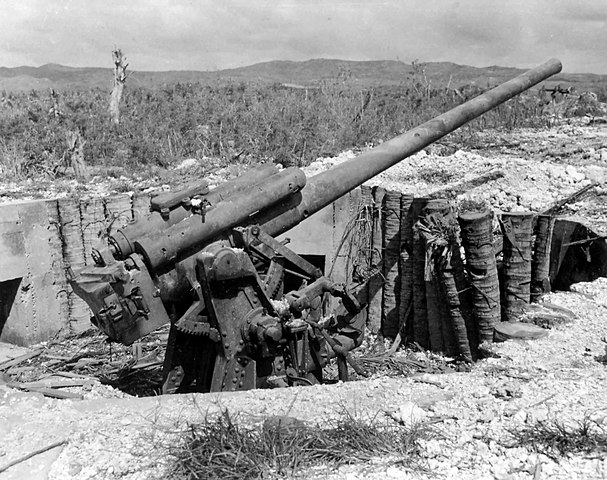
This “universal” weapon was originally designed in 1918 for ship use, produced from 1921 in large numbers (2000) until 1945. It was fiven a pedestal for land use as dual-purpose gun and an autofretted barrel, mono-block construction, sleeve cradle. Its basic mount allowed 360° of traverse and there as an hydro-spring recoil mechanism attached to the sleeve cradle plus three recoil cylinders on top of the breech and two outside cylinders for the recoil springs, with a center cylinder housing the hydraulic recuperator, a combination that was quite efficient. Right elevating handwheel, left traversing handwheel and spring equilibrators below the gun barrel. Well balanced, fast and easy to elevate to +75 degrees its semi-automatic horizontal sliding-wedge breech was designe to quickly fire (10-12 rpm) the Fixed QF 120 x 708R ammunition, 20.6 kg (45 lb 7 oz) HE/incendiary shrapnel, but 32.4 kg (71 lb 7 oz) complete round so it was tiresome for the crew.
Mass: 8.5 tons, 5.94 m (19 ft 6 in) (barrel 5.4 m) L/45, width 2.16 m (7 ft 1 in), eight 2.34 m (7 ft 8 in), Fixed QF ammunition 120 x 708R.
Muzzle velocity 825 m/s (2,710 ft/s), effective range 16,000 m (17,000 yd) for ships, 8,500 m (27,900 ft) ceiling. No longer relevant as AA gun in 1941.
8 cm/40 3rd Year Type naval gun
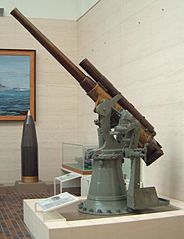 The Japanese Type 41 3-inch (76 mm) or 8 cm/40 3rd Year Type naval gun was a direct copy of the English QF 12-pounder 12 cwt and entered service in 1897. It was produced without interruption until 1945 and constantly improved. The original 12-pounder had a single-motion interrupted screw breech for Fixed QF rounds, with bottom mounted hydro-pneumatic recoil systems. They were standard ATB casemate guns, until 1920 befire a new autofretted monoblock barrel was created with a taller pedestal mount to elevate to +75° as well as a top mounted recoil system, 45° sliding block breech to fire a 5.7–6 kg (12 lb 9 oz – 13 lb 4 oz) HE against aircraft and ships. They were used as secondary dual-purpose guns on most IJN ships but also for coastal defense, or as submarine deck gun.
The Japanese Type 41 3-inch (76 mm) or 8 cm/40 3rd Year Type naval gun was a direct copy of the English QF 12-pounder 12 cwt and entered service in 1897. It was produced without interruption until 1945 and constantly improved. The original 12-pounder had a single-motion interrupted screw breech for Fixed QF rounds, with bottom mounted hydro-pneumatic recoil systems. They were standard ATB casemate guns, until 1920 befire a new autofretted monoblock barrel was created with a taller pedestal mount to elevate to +75° as well as a top mounted recoil system, 45° sliding block breech to fire a 5.7–6 kg (12 lb 9 oz – 13 lb 4 oz) HE against aircraft and ships. They were used as secondary dual-purpose guns on most IJN ships but also for coastal defense, or as submarine deck gun.
It fired at a Muzzle velocity of 670–685 m/s (2,200–2,250 ft/s) up to 13–20 prm up to 5.4 km (18,000 ft) ceiling at +75°, 10,800 m (11,800 yd) at +45° versus ships. Their efficience in 1941 was questionable, yet they remained installed on Notoro until the end of her career.
Conversion of Notoro as Seaplane Carrier
Notoro was converted in 1924 at the same time as her sister Tsurumi, but seemingly in a more intensive way than her sister. The space between her well decks was fitted with a platform, supported by stanchions at at the same height as the bridge to keep vision. This platform provided cover for her eight floatplanes installed on wheeled cradles on the weather deck, with standard cargo booms fitted to lower and recover these and no catapult. They were kept on deck, as the holds below remained operational to carry oil. There is no known photo of Tsurumi as converted to show the level of modifications but this was short lived, from 1924 to 1931.
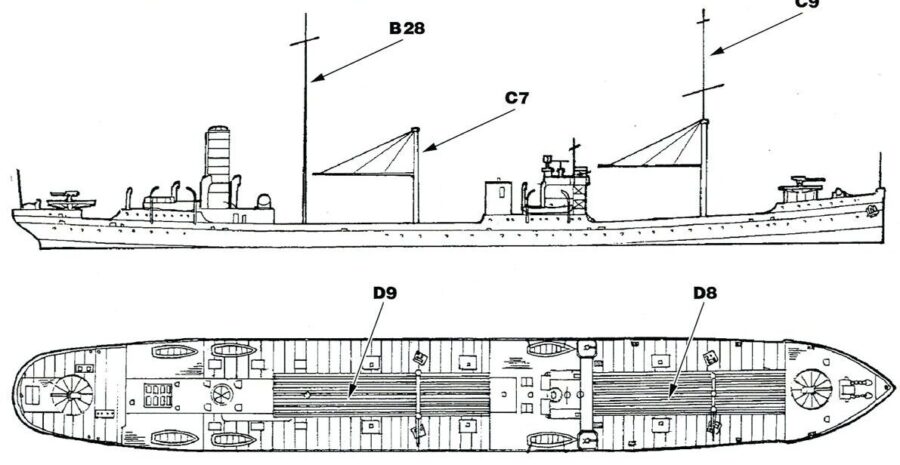
⚙ specifications As seaplane Carrier |
|
| Displacement | 14,050 long tons (14,280 t) standard |
| Dimensions | 143.5 x 17.68 x 8.08 m (470 ft 10 i x 58 ft x 26 ft 6 in) |
| Propulsion | 2 shafts VTE, 6× Miyabara boilers 5,850 shp (4,360 kW) |
| Speed | 12 kn (22 km/h; 14 mph) |
| Range | 8,000 nmi (15,000 km; 9,200 mi) at 7 knots (13 km/h; 8.1 mph) |
| Armament | 2× 120 mm (4.7 in) L/45, 2 × 76.2 mm (3 in) L/40 AA |
| Air Group | 8 seaplanes |
| Crew | 250 |
Air Group
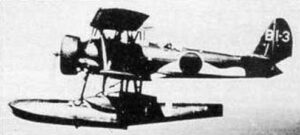 It changed over time. As standard when converted, Notoro and Tsurumi had eight Type 14-1 Yokosuka E1Y1 3-seat reconnaissance floatplanes, plus two disassembled as reserves. Late they carried Type 95 Kawanishi E8N “Dave” 2 seat float biplanes. Aircraft from Notoro had a tail code (white on red) comprising the Notoro code and a tactical number. This identification code changed during in service at first she had the code “ノ ト ロ” (no to ro). In October 1937 this was just “13” and by October 1941 “Z1” then before reconversion as oiler, “N2”.
It changed over time. As standard when converted, Notoro and Tsurumi had eight Type 14-1 Yokosuka E1Y1 3-seat reconnaissance floatplanes, plus two disassembled as reserves. Late they carried Type 95 Kawanishi E8N “Dave” 2 seat float biplanes. Aircraft from Notoro had a tail code (white on red) comprising the Notoro code and a tactical number. This identification code changed during in service at first she had the code “ノ ト ロ” (no to ro). In October 1937 this was just “13” and by October 1941 “Z1” then before reconversion as oiler, “N2”.

Type 14 seaplanes on Tonomi Beach
From 28 June 1927 she carried eight Yokosuka E1Y (4 in reserve) and from May 1929 6(+2) E1Y plus a 1 Yokosuka K1Y trainer.
From 25 May 1932 she had 4(+2) Yokosuka E1Y3 plus two E5Y (1 spare).
From 30 January 1933 she carried six Yokosuka E1Y3 and Yokosuka/Kawanishi E5Y/K (+2 spares) and from October 1933 four Nakajima E4N2 (1 spare), then from May 1934 six E4N2 and E1Y3. After 1937, she carried four Kawanishi E7K, four Nakajima E8N. From July 1941 after reconversion, her aircraft were sent to the Fujikawa Maru.
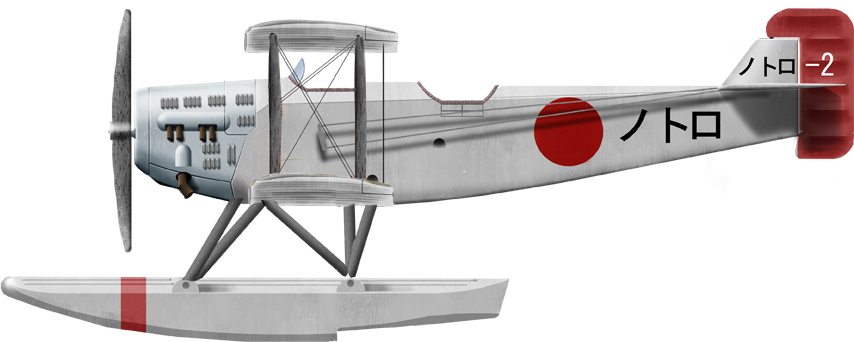
Yokosuka E1Y1, first reconnaissance model on board.
Reconversion as oiler
⚙ specifications as Oiler (1941) |
|
| Displacement | 15,400 long tons (15,647 t) normal |
| Dimensions | 138.68 x 17.68 x 8.08m (455 ft x 58 ft x 26 ft 6 in) |
| Propulsion | 1 shaft TE engine, 4× Scotch boilers 3,750 shp (2,800 kW) |
| Speed | 12 knots (22 km/h; 14 mph) |
| Range | 8,000 tons of fuel oil |
| Armament | 2 × 120 mm (4.7 in) L/45, 2 × 76.2 mm (3 in) L/40 AA |
| Crew | 142 |
 IJN Notoro
IJN Notoro
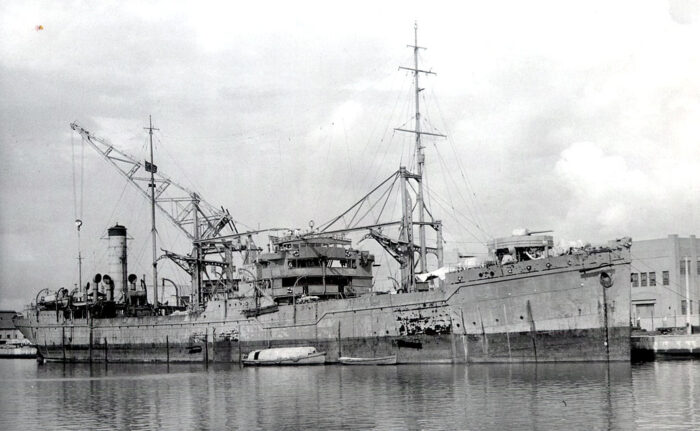
IJN Notoro was the second of her own class, completed a bit later than Shiretoko in September rather than August. She acted as fleet oiler for just three years under Captain Ishiwata as first Commanding Officer, then in December Captain Takakura Masaharu and on 25 July 1921 Captain Miyano Koji, the Tsubota Kozaru, Honda Kazuma, Kioka Hideo, Suzuki Hideji. Then the naval staff decided she would be converted into a seaplane tender to assist fleet operations in the Pacific. Ths conversion started by December 1923 and is completed in June 1924 at the Sasebo Naval Arsenal. She can still operate as a tanker while in the seaplane role, with eight Type 14-1 Yokosuka E1Y1 3-seat reconnaissance floatplanes plus two in parts, in reserve. She could carry up to eight (6 operational, 2 dismantled backup) but had no catapult, using its booms to lower and retrieve the seaplanes at sea. She started training from June to December and on 1 December 1925 she is assigned to the Combined Fleet. From 15 April Kitagawa Kiyoshi took command.
The was an explosion on 5 September 1931 while moored at Yokohama, killing 10 and destroying the aviation fuel tanks, damaging several of her E1Y1 seaplanes.
She was assigned to the operations against China but at first independently from the Combined Fleet. On 28 January she arrived in Shanghai from the Ryojun naval base and was present during the first Shanghai incident. On January 28-29 at night, Notoro’s seaplanes took off and dropped flares, to scare off opposition and help troops secure objectives. Next she sailed into the Yangtze River, and sent its E1Y3 seaplanes to attack targets in Shanghai and Zhabei, notably artillery positions outside the city. They even strafed and bombed an armored train at the Shanghai North railway station.
On 11 May 1932, Notoro was reassigned to the Combined Fleet. From 25 May she was given the new 3-seater seaplanes E5K/E5Y. On 2 October 1937 IJN Taigei (sub tender) brought six E8N2 seaplanes from the 23rd Reconnaissance Group for operations in South China.
On 24 February 1938 she launched five E8N2s, plus the eight from IJn Kinugasa Maru for a raid on Nanxiong (northern Guangdong), some having bombs, the others in escort. But upon arrival they were intercepted by twelve Gladiator Mk. I from the 28th and 29th squadron, 5th wing and several E8Ns were damaged, two crashed while back, crews lost. Another returned with 138 bullet holes and a dead observer, written off after emergency landing. IJN Notoro lost five aircrew and they claimed two Gladiators.
On 24 July 1938, Notoro and Kamikawa Maru provided air support for the 5th SNLF (Special Naval Landing Forces) on the banks of the Yangtze and from 12 to 25 October, she teamed with Kamoi, Kaga, Sōryū and Ryūjō for raids in the Guangdong Province, until Guangzhou fell.
However with the planned attack on Pearl harbor and invasion of the Southwest Pacific, the IJN wanted to reconvert Notoro back to an oiler, more precious in this role. She was directed to carry oil from future occupied territories in the Dutch East Indies, to Japan. The conversion was done between November and December 1941. She also served in the Indian Ocean. On 9 January 1943 she was ambushed by USS Gar in the Makassar Strait, hit by two of three torpedoes and despite the list, she was able to reach Balikpapan, Borneo, for emergency repairs, and proceeded to Singapore, arriving on 31 January 1943.
On 26 May 1943 she sailed with a convoy from Truk, heading for Yokosuka but attacked on 3 June by USS Salmon, which missed. She arrived at Yokosuka on 5 June.
On 20 September 1943 she sailed from Truk with convoy No. 4920 when at 23:00 hours west of Truk, she was hit by a torpedo from USS Haddock and had to sail back. Repairs ended on 24 January 1944. On 25 June she departred with the convoy MISHI-03 from Miri (Borneo) underway to Singapore when on 28 June she was spotted by USS Flasher, and attacked just after midnight. Three fired, all hits. Notoro stopped dead in the water buut was towed on 30 June to Singapore. However personal and parts lacked and work was slow. Plus on 5 November 1944 she was hit by an air raid by 53 B-29 bombers (USAAF), and decommissioned. Next, she was used as floating fuel tank. Sources diverged about her fate, either scrapped in 1947 or sunk as breakwater near Pulau Brani, but stricken on 3 May 1947.
 IJN Tsurumi
IJN Tsurumi
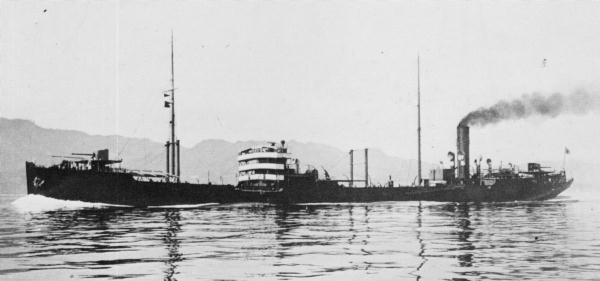
On 10 March 1921, Tsurumi was laid down at the Osaka Ironworks with Captain Kabayama Nobuyuki as Chief Equipping Officer. She was launched on 29 September 1921 and departed on 28 January 1922 for completion at Kobe, Osaka, and on 10 February 1922 she was sent for the coast of Awaji, being back at Osaka. She made several bac and forth runs marred by engines issues on 23 March. On 11 April 1922 she was at Sasebo, left for Tarakan, Borneo with oil for Tokuyama in May.
She made three more runs, and from October 1923 Captain Sugimoto Yukio took command. On 10 March 1923 at Sasebo she received approval for changing her lashing equipment. In 1924 she was converted as a seaplane carrier/tender, and operated as a tanker in the seaplane role with eight Type 14-1 Yokosuka E1Y1 inc. two in reserves, starting training on 13 February 1924 under Captain Kiuchi Tatsuzo. On March 1925 she was called “a special service ship” and Tokuhiro Sakichi took command, then Kurobane Hideo. On 29 November 1926 she was reclassified as transport ship for special service and by December, assigned to the Combined Fleet and from 1927 under captain Ban Jiro, then Ono Isao. It’s on 12 January 1928 tha she received upper deck reinforcement. On 1 November 1928 she took part in the Coronation Special Naval Review and under Tabata Hiroyoshi she was detached from the Combined Fleet. After a refit at Sasebo she departed by November 1929 under captain Maki Kikuta for Ise Bay and on 6 October 1930, resupplied the light cruiser TATSUTA, ABUKUMA, TAMA and DesDiv 24. Suzuki Kozo took command and she was reattached to the combined fleet on 1 February 1931, then she is reconverted to an oiler.
In 1933 she was detached from the Combined Fleet, in service as an active special service ship at Oha. In October 1934 Tada Takeo took command and on the 24th she was reallocated from the battleship YAMASHIRO to the minelayer TOKIWA at Sasebo, reattached to combined fleet on February 1935 and by April 1935 she left the Saddle Islands in China for Sukumo, resupplying DesDiv 10 destroyers. On 17 May 1935 she left for Yokosuk and from July to September 1935 she is attached to the 4th Fleet for the “Red Fleet” Exercise between Japan and the Kuriles. She was present on 25 September 1935 at the “4 Fleet Incident” (major typhoon, ships damaged, 50 men killed).
Fast forward after many captain changes and runs, in 1937 she rejoined the Combined Fleet, 3rd Fleet and sent to Sijiao Shan in China. In August she landed the 22nd Sea Scout Unit to create a seaplane base in the Ma-an Islands. In Sept. she resupplied MINAZUKI, KAMOI and moved for Shidongkouchong August 1940, redsupplied other ships in 1938-39 and in December 1940 she joined the Maizuru Naval District, Combined Fleet from April 1941 as dedicated oil supply ship under Captain Fujita Shunzo. She moved to Hahajima, Chichijima, Kure, Saiki and by 9 February 1942 she was based on Camranh Bay in Indochina.
On 21 February 1942 she was at Anamabas for transfers of heavy oil to TSURUMI from ERIMO and took part in Operation “J” (Invasion of Java) and worked with DesDiv 5 and DesDiv 22, took part in Operation Su and Ya. After the Battle of the Sunda Strait she resupplied PB-35, NATORI, HARUKAZE and ASAKAZE and others and she is attached on 4 March 1942 to the Malaya Force for emergency repair. Later she was at Seletar Naval Bas in Singapore for battle damage repairs, the Kure, Kanokawa, and on 28 May 1942 was part of Operation “MI” (Midway) with the oiler SATA, and by June she ws escorted by Desdiv 2.
She made a cargo run with the 7th Squadron Air Base for Komatsushima and by October 1942 she sailed to Truk in the Carolines, then Shortland, Bougainville, then Kavieng, Rabaul, staying as fleet replenishment tanker. On 9 January 1943 she departed Shortland towing the tender SANYO MARU to Truk.
On 2 February 1943 she loaded four seaplanes from the Shortland Base and saw action when USAAF B-17 raiaded the plane, she was lightly damaged. She moved to Buin airfield and was back to Truk on 15 February 1943 to load oil, coal, fresh food, joining a convoy to Davao and to Jolo, then Palembang in Sumatra, Balikpapan to load crude oil for Pulau Sambu near Singapore for Hosojima, Tokuyama, Kure for maintenance in April.
On 23 April 1943 an accidental fire caused a small explosion in a heavy oil tank. On 11 May 1943 she left Mutsure Jima for Mako, Pescadores, then Miri, Palembang and Surabaya, Java. On 4 June she sailed to Balikpapan and later loaded 8,000-tons of type No. 3 heavy oil for Palau and back in Kure by July 1943.
She sailed for Takao, Formosa and in August was in Manila, then Balikpapan and on 14 August 1943 was caught in an air raid, fired 45 shots and more for her 13 mm machine guns (2000). Same on 18 August 1943. On 24 August she was in Menado, then off Palau she was attacked but missed by USS TUNNY (SS-282). On 2 September 1943 she arrived at Harushima, Truk, refuelled destoyers and the battleship FUSO aznd later arrived at Balikpapan via Tarakan.
She sailed for Woleai, Yap, Palau, Surabaya, Davao, Tarakan (loading oil), Balikpapan, and Palau on 25 October 1943, then on 24 November 1943, Truk. She is camouflaged on 17 December and left Truk for Saipan, Palau, Balikpapan and Surabaya, her co,vopy is attacked by a sub on 26 January 1944.
In February she loaded charcoal, heavy oil and drums for Surabaya, then Kalimantan, Pegatan, Kota Baru for Palau, attacked by missed by USS TUNNY (SS-282). On
31 March 1944 she was in Saipan and on 14 April Tarakan, then Balikpapan with oil, Tawi Tawi on 11 May, resupplying TAIHO o the 15th and later ZUIKAKU, then herself resplenished by SEIYO MARU and JUNYO on the 17th, KONGO the following day, HIYO then, RYUHO at Tawi Tawi. In Tarakan she resupplied TAMA and on 26 May KUMANO and SUZUYA. In June she was in Balikpapan and on the 10th she resupplied KONGO and HARUNA, then TONE and ATAGO, NAGATO and left for Sabah, British Borneo, then sailed to resupply at Tarakan, Balikpapan. On 15 July 1944 she left Tawi Tawi for Jolo, Philippines, then Zamboanga for Malusu Bay, Basilan Island, Lebak Bay, Mindanao and Glan, Malalag, Davao and returned on 5 August to Balikpapan. The same day underway she is spotted and attacked by LtCdr Edward F. Dissette’s USS CERO (SS-225), six torpedoes, claims four hits. At 1130, IJN TSURUMI capsized and sank in Davao Gulf commanded at the time by Captain Yamamoto, which survives. She is stricken on 10 October.
Read More/Src
Books
Ships of the World special issue Vol.47, IJN Auxiliaries, “Kaijinsha”. March 1997
The Maru Special, Japanese Naval Vessels No.34 Japanese auxiliary vessels, “Ushio Shobō”. December 1979
Senshi Sōsho Vol.31, Naval armaments and war preparation (1), “Until November 1941”, Asagumo Simbun (Japan), November 1969
Jentschura, Hans Georg; Jung, Dieter; Mikel, Peter (1986). Warships of the Imperial Japanese Navy 1869-1945. NIP
Links
on combinedfleet.com
on en.wikipedia.org/ Notoro
on navypedia.org/
en.wikipedia.org Notoro-class_oiler
on admiral31.world.coocan.jp
on ja.wikipedia.org/
issuu.com ss-225_cero logs part1
on admiral31.world.coocan.jp/
combinedfleet.com Tsurumi_t.htm
combinedfleet.com Notoro_t.htm
on surfcity.kund.dalnet.se/china_li.htm
Model Kits
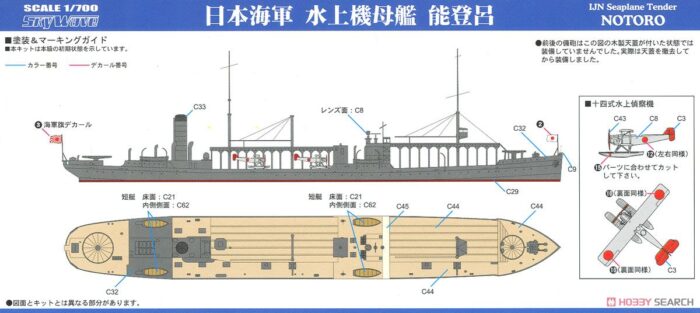
https://www.1999.co.jp/eng/10538481
photo-etch on suruga-ya.jp


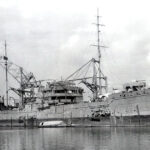
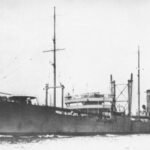
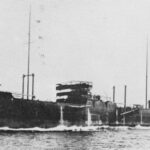
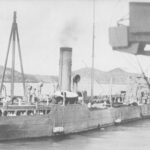
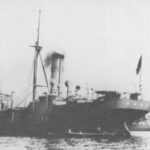
 Latest Facebook Entry -
Latest Facebook Entry -  X(Tweeter) Naval Encyclopedia's deck archive
X(Tweeter) Naval Encyclopedia's deck archive Instagram (@navalencyc)
Instagram (@navalencyc)





 French Navy
French Navy Royal Navy
Royal Navy Russian Navy
Russian Navy Armada Espanola
Armada Espanola Austrian Navy
Austrian Navy K.u.K. Kriegsmarine
K.u.K. Kriegsmarine Dansk Marine
Dansk Marine Nautiko Hellenon
Nautiko Hellenon Koninklije Marine 1870
Koninklije Marine 1870 Marinha do Brasil
Marinha do Brasil Osmanlı Donanması
Osmanlı Donanması Marina Do Peru
Marina Do Peru Marinha do Portugal
Marinha do Portugal Regia Marina 1870
Regia Marina 1870 Nihhon Kaigun 1870
Nihhon Kaigun 1870 Preußische Marine 1870
Preußische Marine 1870 Russkiy Flot 1870
Russkiy Flot 1870 Svenska marinen
Svenska marinen Søværnet
Søværnet Union Navy
Union Navy Confederate Navy
Confederate Navy Armada de Argentina
Armada de Argentina Imperial Chinese Navy
Imperial Chinese Navy Marinha do Portugal
Marinha do Portugal Mexico
Mexico Kaiserliche Marine
Kaiserliche Marine 1898 US Navy
1898 US Navy Sovietskiy Flot
Sovietskiy Flot Royal Canadian Navy
Royal Canadian Navy Royal Australian Navy
Royal Australian Navy RNZN Fleet
RNZN Fleet Chinese Navy 1937
Chinese Navy 1937 Kriegsmarine
Kriegsmarine Chilean Navy
Chilean Navy Danish Navy
Danish Navy Finnish Navy
Finnish Navy Hellenic Navy
Hellenic Navy Polish Navy
Polish Navy Romanian Navy
Romanian Navy Turkish Navy
Turkish Navy Royal Yugoslav Navy
Royal Yugoslav Navy Royal Thai Navy
Royal Thai Navy Minor Navies
Minor Navies Albania
Albania Austria
Austria Belgium
Belgium Columbia
Columbia Costa Rica
Costa Rica Cuba
Cuba Czechoslovakia
Czechoslovakia Dominican Republic
Dominican Republic Haiti
Haiti Hungary
Hungary Honduras
Honduras Estonia
Estonia Iceland
Iceland Eire
Eire Equador
Equador Iran
Iran Iraq
Iraq Latvia
Latvia Liberia
Liberia Lithuania
Lithuania Mandchukuo
Mandchukuo Morocco
Morocco Nicaragua
Nicaragua Persia
Persia San Salvador
San Salvador Sarawak
Sarawak Uruguay
Uruguay Venezuela
Venezuela Zanzibar
Zanzibar Warsaw Pact Navies
Warsaw Pact Navies Bulgaria
Bulgaria Hungary
Hungary

 Bundesmarine
Bundesmarine Dutch Navy
Dutch Navy Hellenic Navy
Hellenic Navy Marina Militare
Marina Militare Yugoslav Navy
Yugoslav Navy Chinese Navy
Chinese Navy Indian Navy
Indian Navy Indonesian Navy
Indonesian Navy JMSDF
JMSDF North Korean Navy
North Korean Navy Pakistani Navy
Pakistani Navy Philippines Navy
Philippines Navy ROKN
ROKN Rep. of Singapore Navy
Rep. of Singapore Navy Taiwanese Navy
Taiwanese Navy IDF Navy
IDF Navy Saudi Navy
Saudi Navy Royal New Zealand Navy
Royal New Zealand Navy Egyptian Navy
Egyptian Navy South African Navy
South African Navy






























 Ukrainian Navy
Ukrainian Navy dbodesign
dbodesign